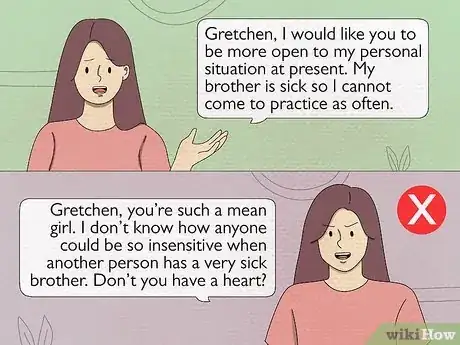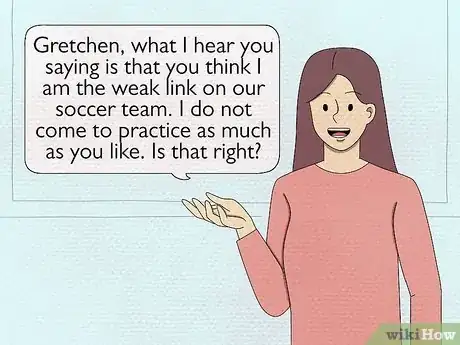This article was co-authored by Christy Irvine, PhD. Dr. Christy Irvine is a Licensed Clinical Psychologist and the owner of her private practice out of Portland, Oregon. With over 10 years of experience, she specializes in individual and couples therapy using various techniques including Emotionally Focused Therapy (EFT), Acceptance and Commitment Therapy (ACT), Interpersonal-Process Therapy, and Cognitive Processing Therapy (CPT). Dr. Irvine holds a B.A. in Psychology from Whitman College and a Ph.D. in Clinical Psychology from The University of Connecticut.
This article has been viewed 36,982 times.
Standing up for yourself takes confidence. When you want to be aware of others’ feelings, you must be careful. By using assertive communications skills, you can demonstrate what you want and respect others.
Steps
Practicing Assertive Communication
-
1Recognize the difference between assertive and aggressive responses. Being assertive means you stand up for yourself and share your thoughts and feelings with others. You do not want to hurt others with your words. Instead, you want to make your point known. Aggressive language occurs when you belittle others. You might be proving your point at the expense of another.
- Assertive communication would be: “Gretchen, I would like you to be more open to my personal situation at present. My brother is sick so I cannot come to practice as often.” See be assertive for more tips.
- Aggressive communication would be: “Gretchen, you’re such a mean girl. I don’t know how anyone could be so insensitive when another person has a very sick brother. Don’t you have a heart?”
- Being assertive is all about expressing your boundaries and limits.[1]
-
2Use assertive body language. Stand tall with your shoulders back. Don't slouch or lean against a wall. Keep your head high and look people in their eyes. Rather than crossing your arms, keep them at your sides or even on your hips. If sitting, keep your legs uncrossed with your feet planted firmly on the floor.Advertisement
-
3Lean towards “I” statements. Instead of using the accusatory “you,” frame your responses with “I.”[2] For example, “I feel hurt when you ignore my needs” rather than “You always forget that I need a ride.” By keeping the focus on “I,” you are less likely to issue blame. Instead, you open a dialogue.
-
4Do not be defensive.[5] When standing up for yourself, try to state facts. Do not just defend yourself. For example, saying, “Gretchen, you’re being unfair!” will be ineffective. Although it is important to say when someone hurts your feelings, explain why. Saying that you’re sad helps if people know the reason. Try the following:
- You might say, “Gretchen, I feel like you do not understand why I miss practice so often. My brother is very sick and my family travels twice a week one hour to visit him in the hospital. I want to be committed to the team but right now, my brother is more important. I hope you can understand.”
-
5Remember you decide the worthiness of your thoughts. If someone is belittling you, realize that no one can make your thoughts worthless.[6] If you think them, they are valuable. That does not mean they are always right. Thus, be aware of the full situation and try to keep an open mind.
-
6Explain cultural or lifestyle differences. Not every disagreement needs to be resolved. Occasionally, you can explain simply from where you’re coming. Some level of disagreement is completely normal in every relationship.[7]
- For example, perhaps your religion forbids alcohol and for this reason, you don’t want alcohol served at a joint birthday party. Although your friend might disagree, if she realizes the theme is important for religious reasons, she might be more inclined to agree.
Listening to Others
-
1Stay calm. When having conflicts with others, take a deep breath. Do not react immediately. Make sure that you are calm enough to discuss a situation rationally.
- If you are not calm and ready to discuss a situation, say so. For example, "Please give me a five minute break. Then I can return to this situation."
- Try counting to ten while breathing low from your diaphragm. Let your breath out slowly.
-
2Let others speak. When you are having a conflict with someone, hear that person’s side of the story. Do not interrupt. Even if you need to stick up for yourself, you will be more aware of the person’s perspective. This will help you communicate more effectively.
- Do not dismiss others’ thoughts as nonsense.[8] That is aggressive and unproductive behavior.
- Show that you are listening through verbal and visual cues. Nod your head and look the person in her eyes. Offer verbal responses like “right,” “yes,” “mhmm.”
-
3Summarize another’s thoughts. After your conversation partner has finished speaking, repeat what you have heard. This will help prevent any misunderstandings. It will also demonstrate that you are trying to understand the other person.
- For example, you might say: “Gretchen, what I hear you saying is that you think I am the weak link on our soccer team. I do not come to practice as much as you like. Is that right?”
-
4Ask questions. After your friend has explained her position, take the time to clarify any questions or doubts you might have. Asking questions shows deeper interest than simply accepting what another person says. Additionally, if a person is hesitant to share her view, ask her questions specifically:[9]
- You might say: “Gretchen, I’ve noticed that you seem frustrated with me. Have I done something to offend you?" Gretchen might not be mad that you're the weakest player on the team. She could be annoyed by your lack of attendance. She might see real potential in you and be frustrated that you are not committing as much as you could.
References
- ↑ Christy Irvine, PhD. Licensed Clinical Psychologist. Expert Interview. 9 April 2021.
- ↑ Christy Irvine, PhD. Licensed Clinical Psychologist. Expert Interview. 9 April 2021.
- ↑ Christy Irvine, PhD. Licensed Clinical Psychologist. Expert Interview. 9 April 2021.
- ↑ Christy Irvine, PhD. Licensed Clinical Psychologist. Expert Interview. 9 April 2021.
- ↑ https://www.psychologytoday.com/blog/evolution-the-self/201209/how-and-how-not-stand-yourself
- ↑ https://www.psychologytoday.com/blog/evolution-the-self/201209/how-and-how-not-stand-yourself
- ↑ https://www.psychologytoday.com/blog/evolution-the-self/201209/how-and-how-not-stand-yourself
- ↑ https://www.psychologytoday.com/blog/evolution-the-self/201209/how-and-how-not-stand-yourself
- ↑ https://www.psychologytoday.com/blog/evolution-the-self/201209/how-and-how-not-stand-yourself





































































